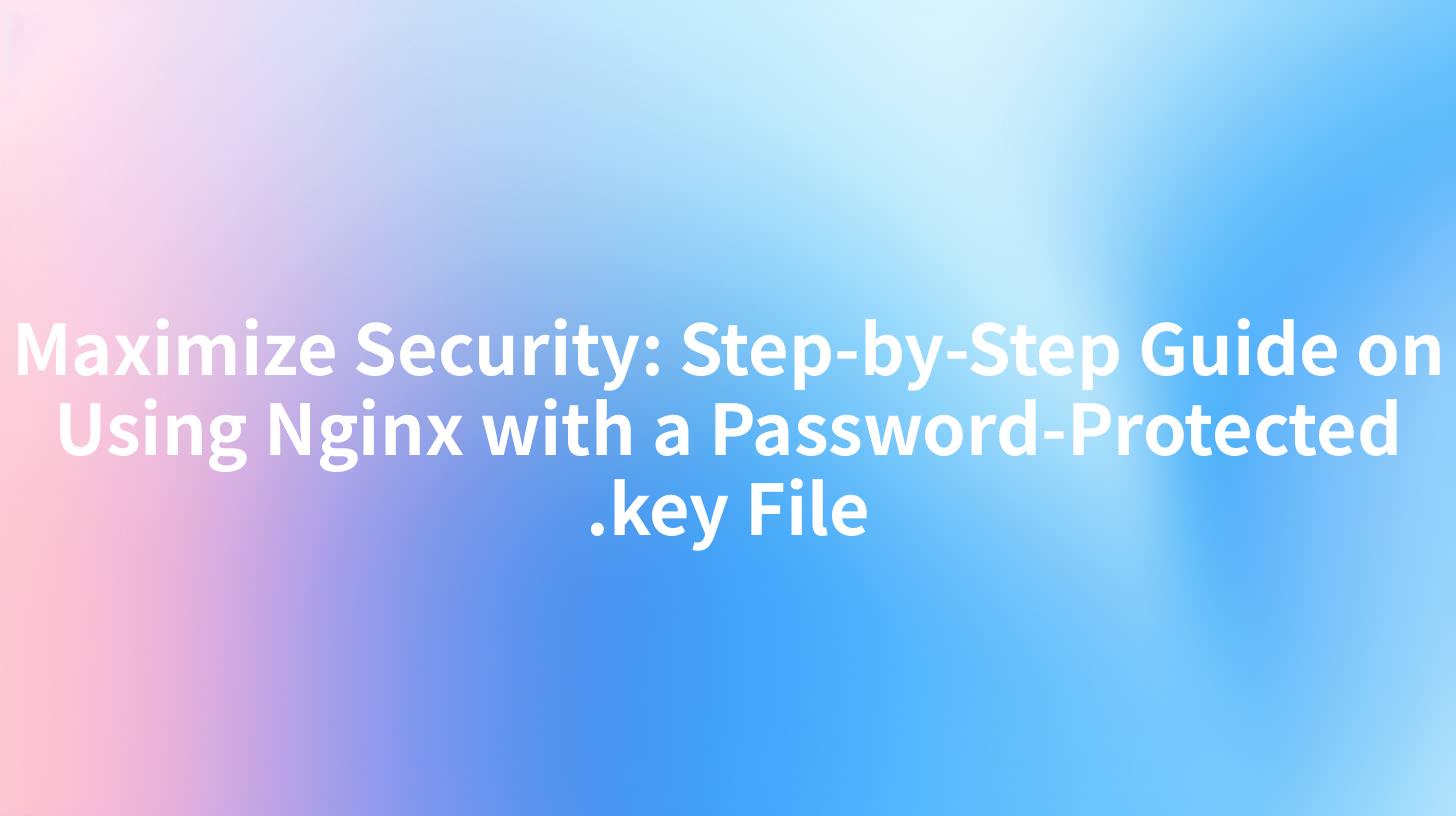Maximize Security: Step-by-Step Guide on Using Nginx with a Password-Protected .key File

In the digital age, ensuring the security of your web server is paramount. One of the most effective ways to enhance the security of your Nginx server is by using a password-protected .key file. This guide will walk you through the process of setting up Nginx with a password-protected .key file, step-by-step, to help you maximize your server's security.
Introduction to Nginx and .key Files
Nginx is a high-performance web server and reverse proxy server, known for its stability, security, and efficiency. It is widely used for serving static files, proxying requests, and running web applications.
A .key file, on the other hand, is a file that contains the private key used for SSL/TLS encryption. By protecting this file with a password, you can add an extra layer of security to your Nginx server.
Why Use a Password-Protected .key File?
Using a password-protected .key file is crucial for several reasons:
- Prevent Unauthorized Access: By requiring a password to access the
.keyfile, you can prevent unauthorized users from obtaining your private key and decrypting your SSL/TLS traffic. - Enhance Security: Password-protected
.keyfiles are more secure than unencrypted ones, as they require an additional layer of authentication. - Compliance: Many organizations require the use of password-protected private keys to comply with industry standards and regulations.
APIPark is a high-performance AI gateway that allows you to securely access the most comprehensive LLM APIs globally on the APIPark platform, including OpenAI, Anthropic, Mistral, Llama2, Google Gemini, and more.Try APIPark now! 👇👇👇
Step-by-Step Guide to Using Nginx with a Password-Protected .key File
Step 1: Generate a Private Key and a Password-Protected .key File
First, you need to generate a private key and a password-protected .key file. You can use the openssl command-line tool to do this.
openssl genpkey -algorithm RSA -out private.key
openssl rsa -aes256 -in private.key -out password-protected.key
Step 2: Create a Certificate Signing Request (CSR)
Next, you need to create a Certificate Signing Request (CSR) for your domain. The CSR is used to generate your SSL/TLS certificate.
openssl req -new -key password-protected.key -out certificate.csr
Step 3: Generate an SSL/TLS Certificate
Once you have your CSR, you can generate your SSL/TLS certificate using a certificate authority (CA). You can use a free CA like Let's Encrypt or a paid CA like Symantec.
openssl x509 -req -days 365 -in certificate.csr -signkey password-protected.key -out certificate.crt
Step 4: Configure Nginx to Use the Password-Protected .key File
Now, you need to configure Nginx to use the password-protected .key file. Open your Nginx configuration file (usually located at /etc/nginx/nginx.conf) and add the following lines:
server {
listen 443 ssl;
server_name yourdomain.com;
ssl_certificate /path/to/certificate.crt;
ssl_certificate_key /path/to/password-protected.key;
ssl_session_timeout 1d;
ssl_session_cache shared:SSL:50m;
ssl_session_tickets off;
ssl_protocols TLSv1.2 TLSv1.3;
ssl_ciphers 'ECDHE-ECDSA-AES128-GCM-SHA256:ECDHE-RSA-AES128-GCM-SHA256...';
ssl_prefer_server_ciphers on;
location / {
root /var/www/html;
index index.html index.htm;
}
}
Step 5: Restart Nginx
Finally, restart Nginx to apply the changes:
sudo systemctl restart nginx
Conclusion
By following this step-by-step guide, you can maximize the security of your Nginx server by using a password-protected .key file. Remember to keep your private key and password secure, and regularly update your SSL/TLS certificate to ensure the ongoing security of your server.
Table: Comparison of Nginx Configuration Settings
| Setting | Description | Example |
|---|---|---|
ssl_certificate |
Specifies the path to the SSL/TLS certificate file. | /path/to/certificate.crt |
ssl_certificate_key |
Specifies the path to the password-protected .key file. |
/path/to/password-protected.key |
ssl_session_timeout |
Sets the timeout for SSL sessions. | 1d |
ssl_session_cache |
Specifies the cache for SSL sessions. | shared:SSL:50m |
ssl_session_tickets |
Disables SSL session tickets. | off |
ssl_protocols |
Specifies the SSL protocols to use. | TLSv1.2 TLSv1.3 |
ssl_ciphers |
Specifies the SSL ciphers to use. | 'ECDHE-ECDSA-AES128-GCM-SHA256:ECDHE-RSA-AES128-GCM-SHA256...' |
ssl_prefer_server_ciphers |
Enables prefer server ciphers. | on |
FAQs
Q1: Can I use a password-protected .key file with other web servers? A1: Yes, you can use a password-protected .key file with other web servers that support SSL/TLS encryption, such as Apache and IIS.
Q2: How often should I update my SSL/TLS certificate? A2: It is recommended to update your SSL/TLS certificate every 365 days to ensure ongoing security.
Q3: Can I use the same .key file for multiple domains? A3: Yes, you can use the same .key file for multiple domains, but you will need to create a separate SSL/TLS certificate for each domain.
Q4: What is the difference between a .key file and a .crt file? A4: A .key file contains the private key used for SSL/TLS encryption, while a .crt file contains the public key and other information about the certificate.
Q5: How can I check if my Nginx server is using the password-protected .key file? A5: You can check if your Nginx server is using the password-protected .key file by looking at the ssl_certificate_key directive in your Nginx configuration file.
🚀You can securely and efficiently call the OpenAI API on APIPark in just two steps:
Step 1: Deploy the APIPark AI gateway in 5 minutes.
APIPark is developed based on Golang, offering strong product performance and low development and maintenance costs. You can deploy APIPark with a single command line.
curl -sSO https://download.apipark.com/install/quick-start.sh; bash quick-start.sh

In my experience, you can see the successful deployment interface within 5 to 10 minutes. Then, you can log in to APIPark using your account.

Step 2: Call the OpenAI API.


